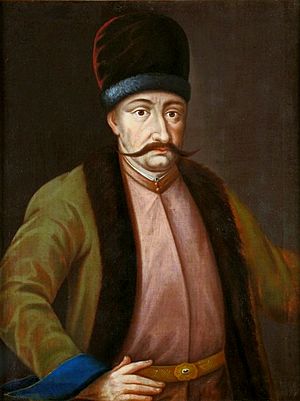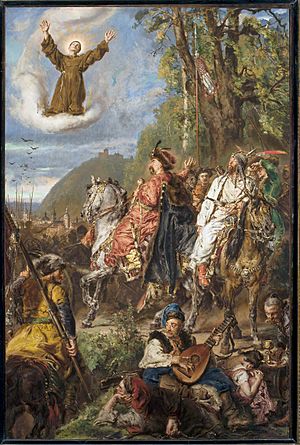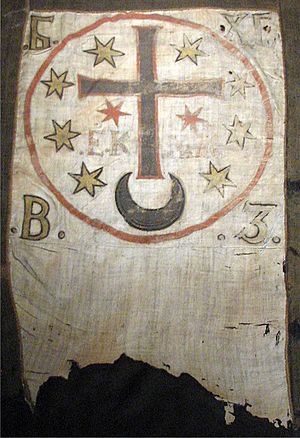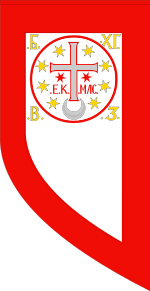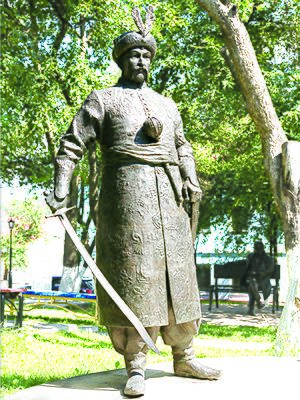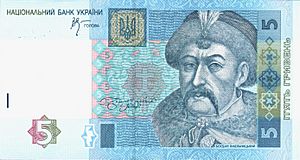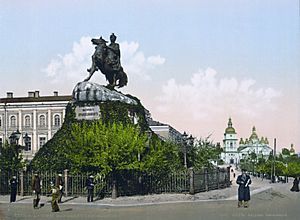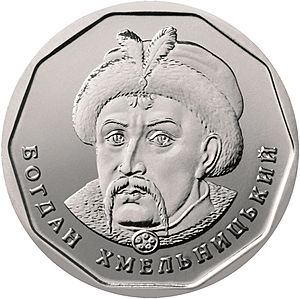Bohdan Khmelnytsky facts for kids
Quick facts for kids
Bohdan Khmelnytsky
Богдан Хмельницький |
|
|---|---|
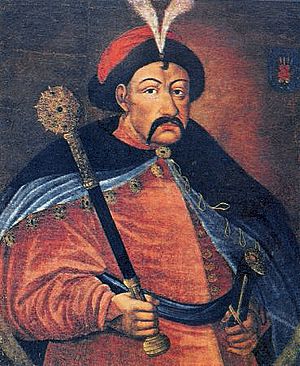
Mid-17th century portrait of Bohdan Khmelnytskyi from Chernihiv
|
|
| Hetman of Zaporizhian Host | |
| In office 30 January 1648 – 6 August 1657 |
|
| Preceded by | position created |
| Succeeded by | Yurii Khmelnytsky |
| Personal details | |
| Born |
Bohdan Zynovii Mykhailovych Khmelnytskyi
1595 Subotiv, Kiev Voivodeship, Polish–Lithuanian Commonwealth |
| Died | 6 August 1657 (aged 61–62) Chyhyryn, Cossack Hetmanate |
| Resting place | Illinska Church in Subotiv |
| Nationality | Ruthenian (Ukrainian) |
| Spouses | Hanna Somko Helena Czaplińska Hanna Zolotarenko |
| Children | Tymish, Yurii, Hryhorii, Ostap, Kateryna, Stepanyda, Olena, Maria |
| Signature |  |
Bohdan Khmelnytsky (born around 1595 – died August 6, 1657) was a famous nobleman and military leader of the Ukrainian Cossacks. He became the Hetman (leader) of the Zaporozhian Host, which was part of the Polish–Lithuanian Commonwealth at the time.
Khmelnytsky led a big uprising against the Commonwealth and its powerful nobles from 1648 to 1654. This rebellion led to the creation of an independent Cossack state in Ukraine. In 1654, he made an important agreement called the Treaty of Pereyaslav with the Russian Tsar. This alliance placed central Ukraine under Russia's protection. During the uprising, there were also very sad events, including attacks on Jewish communities, which caused great suffering.
Contents
Early Life and Education
|
Bohdan Khmelnytsky
|
|
|---|---|
| Coat of arms | 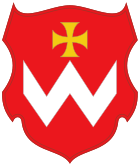 |
| Noble family | Khmelnytsky family |
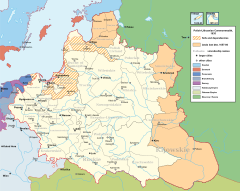
Historians believe Bohdan Khmelnytsky was born in 1595. He was likely born in the village of Subotiv, near Chyhyryn, which was then part of the Crown of the Kingdom of Poland. His father, Mykhailo Khmelnytsky, was a courtier and later a deputy for a local official. Mykhailo was given land where he set up his home in Subotiv.
Bohdan came from a family of lesser nobles in Ukraine. His father's position helped Bohdan be seen as a nobleman. However, during his later uprising, Bohdan also spoke about his mother's Cossack background and his father's brave actions with the Cossacks.
Khmelnytsky went to a Jesuit college, possibly in Lviv. He finished his studies by 1617. There, he learned a lot about world history and became fluent in Polish and Latin. Later, he also learned Turkish, Tatar, and French. Even though he went to a Catholic school, he remained true to his Orthodox faith.
Family Life
Bohdan Khmelnytsky married Hanna Somkivna. She was the sister of a wealthy Cossack from Pereyaslavl. They lived in Subotiv and had several children. Their daughters were Stepanyda, Olena, and Kateryna. Their first son, Tymish, was born in 1632, and another son, Yuriy, was born in 1640.
Becoming a Registered Cossack
After finishing school in 1617, Khmelnytsky joined the Cossacks. In 1619, he and his father went to Moldavia to fight against the Ottoman Empire. During the Battle of Cecora in 1620, his father was killed. Young Khmelnytsky was captured by the Turks and spent two years as a prisoner in Constantinople. Some stories say he was a rower on an Ottoman galley, where he learned Turkic languages.
After being freed, Khmelnytsky returned to Subotiv. He took over his father's estate and became a registered Cossack in the Chyhyryn Regiment. These were Cossacks officially recognized by the Polish government.
He served loyally and became a military clerk for the registered Cossacks in 1637. This was after a Cossack uprising led by Pavlyuk. Khmelnytsky was involved in signing the surrender agreement. He also became a sotnik (a type of officer) in the Chyhryn regiment.
The Czapliński Affair
After a powerful Polish nobleman named Stanisław Koniecpolski died in 1646, his son, Aleksander, claimed Khmelnytsky's family estate. Khmelnytsky tried to get help from the Polish king, Władysław IV. The king gave him a special document protecting his rights to the Subotiv estate. However, in those days, even the king couldn't always stop powerful local nobles.
In 1647, a local official named Daniel Czapliński began to harass Khmelnytsky. Czapliński raided Khmelnytsky's estate twice, causing damage and beating his son Yuriy. In April 1647, Czapliński successfully forced Khmelnytsky off his land. Khmelnytsky and his family had to move to a relative's house.
Khmelnytsky tried again to get the king's help, but the king didn't want to challenge the powerful noble. Around this time, Khmelnytsky also lost his wife, Hanna. He later remarried to Motrona, who was Daniel Czapliński's wife at the time.
Since he couldn't get help from Polish officials, Khmelnytsky turned to his Cossack friends. His own Chyhyryn regiment and other Cossacks supported him. He traveled around Ukraine, talking to Cossack leaders. This made the Polish authorities suspicious, and Khmelnytsky was arrested. He was supposed to be executed, but a Cossack leader helped him escape. Khmelnytsky then went to the Zaporozhian Sich, a Cossack stronghold, with his supporters.
The Uprising Begins
The "Czapliński Affair" was the immediate reason for the uprising. But it was also a spark for much bigger problems. People were unhappy about religion, their ethnic identity, and economic issues. Many Orthodox Ukrainians felt ignored and oppressed by Polish nobles. The spread of Catholicism also made relations worse between the Orthodox and Catholic Churches.
First Victories
In late 1647, Khmelnytsky reached the Dnieper river. On December 7, his small group of 300-500 men, helped by some registered Cossacks, took over the Zaporozhian Sich. The Poles tried to get it back but were defeated as more Cossacks joined Khmelnytsky. In January 1648, the Cossacks held a meeting (a Rada) and chose Khmelnytsky as their Hetman.
Khmelnytsky quickly prepared for war. He sent letters to Cossacks and Orthodox peasants across Ukraine, asking them to join the rebellion. He also made alliances, most importantly with the Khan of Crimea, İslâm III Giray.
Polish authorities didn't take the rebellion seriously at first. They demanded the Cossacks surrender. But Khmelnytsky and the Cossacks demanded their old rights back. They wanted an end to the spread of the Ukrainian Greek Catholic Church and for Polish troops to leave Ukraine. The Polish nobles refused.
Khmelnytsky decided to attack the Poles. On May 16, 1648, at Zhovti Vody, the Cossacks, with help from the Tatars, won a big victory. They won again soon after at the Battle of Korsuń on May 26, 1648. Khmelnytsky was a skilled leader, using smart battle plans and gaining strong allies.
Building the Cossack State
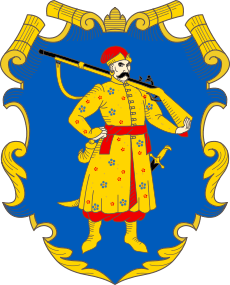
After his early military successes, Khmelnytsky began to build a new Ukrainian state. The Patriarch of Jerusalem, who visited Kyiv, even called Khmelnytsky the "Prince of Rus," a leader of an independent Ukrainian state. In February 1649, Khmelnytsky declared he was "the sole ruler of Rus" and had power over a large area of Ukraine.
Khmelnytsky made the Zaporozhian Host the main power in this new state. He brought all parts of Ukrainian society under his control. He created a new government system and developed both military and civilian leadership.
New leaders emerged during this time, like Ivan Vyhovsky and Ivan Bohun. These Cossack officers formed a new elite within the Cossack Hetman state. They worked to keep the Cossack Hetmanate independent, even when Russia tried to control it.
Challenges and Setbacks
Khmelnytsky's early victories were followed by difficulties. Neither the Cossacks nor the Commonwealth were strong enough to win completely. There were many battles and peace treaties, but they often didn't last. From 1649, things got harder for the Cossacks.
The Treaty of Zboriv in August 1649 was not good for the Cossacks. Then, a big defeat happened at the battle of Berestechko in June 1651. The Tatars betrayed Khmelnytsky and captured him. The Cossacks lost many soldiers, and they had to sign another treaty, the Treaty of Bila Tserkva, which favored Poland.
War continued almost constantly. The Crimean Tatars played a key role, often switching sides. They wanted to keep both Ukraine and Poland from becoming too strong.
Because of these challenges, Khmelnytsky started looking for a new ally. The new Cossack state needed official recognition from a foreign monarch. In 1651, he contacted the Ottoman sultan, who offered to make Ukraine a vassal state, like Crimea or Moldavia. However, most Cossacks and the general population didn't like the idea of an alliance with a Muslim ruler.
The other possible ally was the Tsardom of Russia. Khmelnytsky asked for help based on their shared Orthodox faith. The Tsar waited, but when the idea of a Cossack-Ottoman alliance grew in 1653, he finally decided to act.
Treaty with the Tsar
After many talks, the Cossacks agreed to accept the Tsar Alexei Mikhailovich as their overlord. To make the treaty official, a Russian group came to Pereyaslav. On January 18, 1654, the Cossack Rada (council) met and agreed to the treaty.
Historians still discuss what Khmelnytsky and the Tsar intended with this agreement. The treaty helped Russia claim the capital of Kievan Rus' and increased the Tsar's power in the region. Khmelnytsky needed the treaty for protection and support from a friendly Orthodox power.
During the oath ceremony, the Russian envoy refused to make an oath back to the Cossacks, which was different from what the Cossacks expected from a Polish king. Khmelnytsky was very upset and threatened to cancel the treaty. But the Cossacks decided to go ahead with the agreement.
Final Years and Legacy
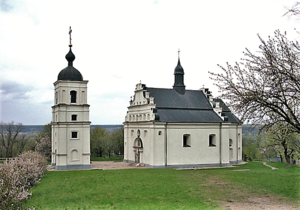
The 1654 Treaty of Pereyaslav changed the map of the region. Russia became a major player. The Tatars, who were once Cossack allies, switched to the Polish side and fought against Khmelnytsky.
Russia attacked Sweden in 1656. This made things complicated for Khmelnytsky, as his ally (the Tsar) was now fighting another ally (Sweden). There were also disagreements between the Tsar and Khmelnytsky, especially about Russian officials interfering in the Cossack state's money and newly captured lands. The Tsar even made a separate treaty with the Poles in 1656 without inviting Khmelnytsky's representatives.
Khmelnytsky wrote an angry letter to the Tsar, saying he broke the Pereyaslav agreement. He even said the Swedes were more honorable than the Russians.
In Poland, the Cossack army and their allies from Transylvania faced difficulties. Khmelnytsky also had to deal with a Cossack rebellion at home. News came that the Tatars, allied with Poland, were planning a new attack on Ukraine.
Even though he was very ill, Khmelnytsky continued his diplomatic work. He even met the Tsar's envoys from his bed. On July 22, 1657, he suffered a stroke and became paralyzed. Less than a week later, Bohdan Khmelnytsky died on July 27, 1657. His funeral was on August 23, and he was buried in his family church in Subotiv.
Khmelnytsky had a huge impact on Ukraine's history. He not only shaped Ukraine's future but also changed the balance of power in Europe. His actions are seen differently by different people, even today.
Ukrainian View
In Ukraine, Bohdan Khmelnytsky is generally seen as a national hero. A city and a region are named after him. His picture is on Ukrainian banknotes, and his monument is a famous landmark in Kyiv. There is also an Order of Bohdan Khmelnytsky, one of Ukraine's highest awards.
However, not everyone in Ukraine agrees completely. Some criticize him for his alliance with Russia, which they believe was bad for Ukraine's future. Others criticize his alliance with the Crimean Tatars, which allowed the Tatars to take many Ukrainian peasants as slaves. Despite these criticisms, most Ukrainians today view his legacy positively. Many believe the alliance with Russia was a necessary choice for survival during a difficult time.
In a 2018 poll, 73% of Ukrainians had a positive view of Khmelnytsky.
Polish View
In Poland, Khmelnytsky's role is mostly seen negatively. His rebellion in 1648 marked the end of the "Golden Age" of the Polish–Lithuanian Commonwealth. Many Poles blame Khmelnytsky for the decline of the Commonwealth, which was later divided among Russia, Prussia, and Austria.
Khmelnytsky has appeared in Polish literature, most notably in Henryk Sienkiewicz's novel With Fire and Sword.
Russian and Soviet View
Official Russian history often says that Khmelnytsky joined the Tsar to "re-unify" Ukraine with Russia. This view supported the idea that Moscow was the rightful heir to Kievan Rus' and was gathering its former lands.
Khmelnytsky was seen as a Russian national hero for bringing Ukraine into the "eternal union" of all the Russias. His role was presented as an example for all Ukrainians to follow: to seek closer ties with Russia. A monument to him in Kyiv, built in 1888, has an inscription that reads "To Bohdan Khmelnytsky from one and indivisible Russia."
Soviet historiography (the way history was written in the Soviet Union) also praised Khmelnytsky for uniting Ukraine with Russia. They also added that he organized the class struggle of Ukrainian peasants against Polish nobles.
Jewish History View
In Jewish history, the view of Khmelnytsky is very negative. He blamed Jewish people for helping Polish nobles, as they often worked as tax collectors. The Khmelnytsky Uprising led to the deaths of thousands of Jewish people in the region. Because of a lack of clear records, it's hard for historians to know the exact number of victims. Stories of terrible acts spread across Europe. This period is considered one of the most painful events in Jewish history.
Commemoration
- The Ukrainian city of Khmelnytskyi is named after him.
- Many cities in Ukraine have streets named Bohdan Khmelnytskyi.
- The Separate Presidential Brigade "Hetman Bohdan Khmelnytskyi", a military unit in Ukraine, is named in his honor.
See also
 In Spanish: Bogdán Jmelnitski para niños
In Spanish: Bogdán Jmelnitski para niños
- Bohdan Khmelnytsky Bridge in Moscow
- List of Ukrainian rulers
- Order of Bohdan Khmelnytsky, a state military award in Ukraine
- Order of Bogdan Khmelnitsky (Soviet Union)
- With Fire and Sword (1884), an historical novel by the Polish author Henryk Sienkiewicz about these events.


